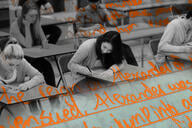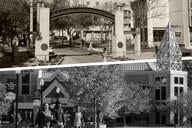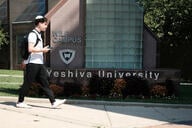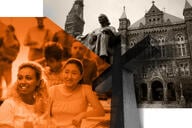You have /5 articles left.
Sign up for a free account or log in.
At Boston College, the placement of Christian art, including crucifixes, in classrooms over winter break has stirred some intense discussions over that particular expression of the Roman Catholic (and catholic) university’s identity. And over whether it's undergoing an identity crisis.
“A classroom is a place where I am supposed, as a teacher, to teach without any bias, to teach the truth. And when you put an icon or an emblem or a flag, it confuses the matter,” said Amir Hoveyda, the chemistry department chair.
“For 18 years, I taught at a university where I was allowed to teach in an environment where I felt comfortable. And all the sudden, without any discussion, without any warning, without any intellectual debate, literally during the middle of the night during a break, these icons appear,” Hoveyda said.
Jack Dunn, Boston College’s spokesman, explained that the Jesuit institution first established a committee on Christian art in 2000. “The crucifixes in question have been brought back largely from students who have gone on immersion trips to Central and South America and to Europe.... The only thing that’s changed really is that in classrooms where crucifixes and iconography and posters hadn’t been present, an attempt has been made to place some form of Christian art and that effort was completed in January,” Dunn said. "The effort was to present Christian art in those remaining classrooms as a way of manifesting our pride in and our commitment to our religious heritage.
“My sense is that they knew there were a certain amount of classrooms that didn’t have any presence of religious art and so they waited until they had a critical mass that would enable them to place the artwork in those classrooms. And that’s the only reason it was done now," Dunn said. There are 151 classrooms.
The process was described by some as gradual, but one faculty member deemed it a “tsunami” of religious art that appeared in classrooms over winter break. And while most discussions on this matter have been private, opinions seem to run the gamut.
In a statement provided through Dunn, Rev. T. Frank Kennedy, chair of the committee on Christian Art, wrote (in part): “I suppose a question might be posed to Boston College as to what purpose this Christian Art serves? In a world that is pretty successfully driven by media (imagery) ours is a response that seeks to pose the age-old invitation of Christ to enter into love – a love that is made perfect in its unselfishness. John Paul II spoke of the crucifix on September 15, 2002 saying ‘It is the sign of God, who has compassion on us, who accepts human weakness, who opens to us all, to one another, and therefore creates the relation of fraternity.’ The Pope also went on to say that though this symbol has been abused in history, it is the Christian’s duty to reclaim that symbol as an invitation to love. An invitation to love, and an invitation to faith is exactly that, an invitation. One is not required to respond, one can decline, and one can have many reasons for declining the invitation, but to imply that a Jesuit and Catholic university is not free to offer this invitation is simply an impossibility.”
Father Kennedy, who is director of Boston College’s Jesuit Institute and a professor of music, continued: “For the identity of Boston College as a Jesuit and Catholic institution which we so proudly have inherited, and so happily transmit to the next generation of alumni/alumnae, impels us as John Paul also noted, 'to offer to share the deep desire we have of recognizing ourselves in the crucifix, and of seeing it, not as something that divides, but as something that is to be respected by all, and that in a certain sense can unify.’ ”
But Dwayne Eugène Carpenter, chair of the romance languages and literatures department and co-director of the Jewish studies program, said the placement of religious art is in fact divisive. These symbols, he said, are not neutral. "I think it's naive to believe that affixing crucifixes is going to fan the flames of religious devotion. On the other hand, it can have a negative effect on students" who might see them as creating an unwelcoming environment.
Carpenter, a professor of Hispanic Studies, said the issue was seriously debated in a recent meeting of the college’s department chairs (Boston College lacks a Faculty Senate at this point). He’d like to see an open forum addressing the subject. So far, he said, it’s been addressed mostly in private conversations, of which he's had many.
“I think there were many people who were upset. But my sense is the majority say, 'This is a Catholic school; they’re going to do what they’re going to do.' I would go on the record as saying, ‘It is true. It’s a Jesuit institution and as such it has every right to place images wherever it wants. It’s just that it’s not a very smart thing to do.' "
“I think it’s in an identity crisis,” Carpenter continued, of Boston College. “At the same time that it wants to proclaim its Catholic identity, it also wants to recruit the best. You can’t recruit the best by placing crucifixes in every classroom. You’re simply going to limit the number of people who will come here. And I’ve already heard of several faculty who have said, ‘You know, this is not a welcoming place, this is not the place that hired me, and I’ll be looking for a job elsewhere.’ ”
Carpenter added that he doesn’t recall any religious art in the classrooms from when he started teaching, in 1990. Hoveyda, the chemistry chair, said the same. He pointed out that much of his job centers around recruiting – faculty, graduate students, even undergraduates. “I can only tell you from my personal experience if I saw the same icon when I interviewed in December 1989, this place would not be under consideration for me. I’ve had several offers to leave. If I knew icons of this type would appear… I most likely would not have made the decision I did [to stay].”
Not every professor feels this way, of course. “Personally, while I deeply respect my university colleagues' right to disagree with the present BC policy, or whatever the present situation should be called, I think too much of a fuss is being made,” said Michael J. Naughton, the physics department chair. “In my opinion, we are undeniably both a catholic and a Catholic university, and there's plenty of evidence, and room, for both.”
The Observer, a BC student publication, originally published an article on professors protesting the crucifixes. The Heights, BC’s weekly student newspaper, approvingly noted the new crucifixes in its “thumbs up/thumbs down” opinion feature: “Upon returning from Christmas break, students may have noticed the new crucifixes in all academic classrooms. This thoughtful gift from the Jesuit community has been long overdue.”
Boston College likes to compare itself to another Jesuit institution, Georgetown University, which “has a crucifix in every classroom and that’s been true for at least a dozen years,” said John Glavin, a professor of English who leads tours, upon request, of Georgetown's iconography. While older Georgetown buildings always had crucifixes in the classroom, university officials made a conscious effort awhile back to add crucifixes to the newer classrooms that did not.
”It was not uncontroversial," Glavin said. "But one of the things that was done, which I think was done very sensitively, was the crucifixes, when they were added to rooms, were placed off-center. A number of faculty said they felt uncomfortable lecturing from the middle of the room, above which was a crucifix, for a broad number of quite respectable reasons. So the idea was in adding these crucifixes, they would be put in a prominent place -- not hidden away, but at the same time, not the place where all eyes would be directed when listening to a faculty lecture.
“There was some fuss and then the fuss died down and it’s never even mentioned now. It’s just sort of an ordinary part of the iconography of the place,” Glavin said.
Dan Kirschner, a professor of biology and the faculty adviser for Boston College’s chapter of Hillel: The Foundation for Jewish Campus Life, said he can see it both ways. “On the one hand, BC wants to be all-inclusive. On the other hand, they do things like this to make people feel not included. On the other hand, it is a Catholic university.” He added that in the lecture hall where he teaches, there’s a small sculpture of a mother and child (Mary and Jesus? – "I suppose," he replied. “Who else would it be?”) – as opposed to a crucifix. “Probably if a crucifix had been placed in my lecture hall, I might have felt more strongly about it not being in my lecture hall."
In addition to the placement of religious art in classrooms, Boston College’s committee on Christian Art has been involved with larger-scale art projects across campus, including two mosaics outside the registrar’s office -- "one of Dorothy Day, of Catholic Worker fame, the other of Pedro Arrupe, S.J. beloved former Superior General of the Society of Jesus who re-inspired us with his invitation to us to become 'men and women for others,'" Father Kennedy, the committee chair, explained. The university commissioned two sculptures: “Tree of Life,” by Peter Rockwell and "St. Ignatius Loyola" (the founder of the Jesuits), by Pablo Eduardo.
In terms of new non-Christian sculptures on campus, “There’s also one of Doug Flutie,” Kirschner said, referencing the famous BC quarterback. “Outside the sports complex.”




